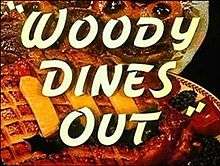Woody Dines Out
Woody Dines Out is the 14th animated cartoon short subject in the Woody Woodpecker series. Released theatrically on April 1, 1945, the film was produced by Walter Lantz Productions and distributed by Universal Pictures.[1] It is the final wartime Woody Woodpecker short released a month before V-E Day and 4 months before V-J Day.
| Woody Dines Out | |
|---|---|
 | |
| Directed by | Shamus Culhane |
| Produced by | Walter Lantz |
| Story by | Ben Hardaway Milt Schaffer |
| Starring | Ben Hardaway Hans Conried |
| Music by | Darrell Calker |
| Animation by | Don Williams Emery Hawkins Pat Matthews Grim Natwick Les Kline |
| Backgrounds by | Phillip DeGuard |
| Color process | Technicolor |
Production company | |
| Distributed by | Universal Pictures |
Release date |
|
Running time | 6' 41" |
| Country | United States |
| Language | English |
Plot
Woody walks about town and realizes that all of the restaurants are closed. He finds one store with a sign in its window that reads: "We stuff birds." He assumes that it is a restaurant when it is actually a taxidermist's shop. He approaches the counter to place his order. From his coat pocket, the taxidermist, an anthropomorphic cat (voice by Hans Conried), removes an ad from the Museum of Natural History announcing a $100,000 reward for a stuffed king-size woodpecker. He secretly places knock-out drops in the food he prepares for Woody. The food puts Woody to sleep, but he recovers on the cutting table. He escapes the taxidermist by climbing onto an elevator; the taxidermist falls down the elevator shaft to the basement, where he abandons his $100,000 ambition
Cultural references
- Frédéric Chopin's "Funeral March" can be heard in the background score as the taxidermist places the knock-out drops into Woody's food.
- The taxidermist refers to Woody's soup as "blackout borscht." At the time of Woody Dines Out's release, blackouts were common among coastal regions of the United States. Borscht is a Russian dish, and the Soviet Union was a member of the Allied Powers at the time.
- As Woody pilots the elevator to faster and faster speeds, the speedometer reads: Is this trip really necessary? This is a reference to the army rationing of gasoline and rubber for the war effort.
- The background for the title card is two plates of food, which ties into the cartoon name.
See also
- List of Woody Woodpecker theatrical cartoons
References
- Lenburg, Jeff (1999). The Encyclopedia of Animated Cartoons. Checkmark Books. pp. 157–158. ISBN 0-8160-3831-7.